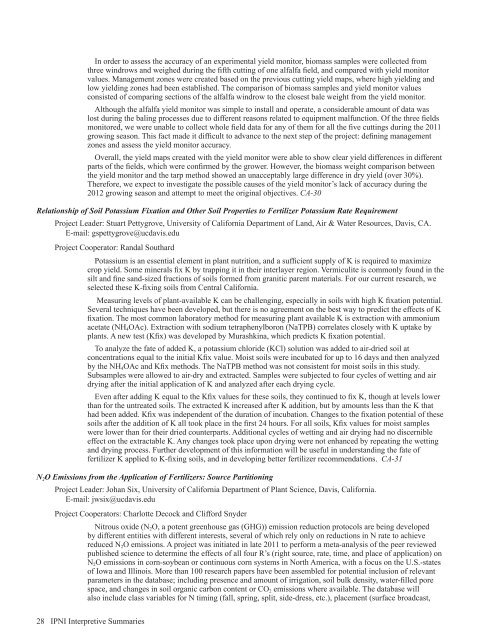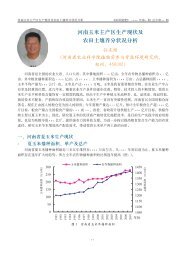Americas and Oceania Group - International Plant Nutrition Institute
Americas and Oceania Group - International Plant Nutrition Institute
Americas and Oceania Group - International Plant Nutrition Institute
You also want an ePaper? Increase the reach of your titles
YUMPU automatically turns print PDFs into web optimized ePapers that Google loves.
In order to assess the accuracy of an experimental yield monitor, biomass samples were collected from<br />
three windrows <strong>and</strong> weighed during the fifth cutting of one alfalfa field, <strong>and</strong> compared with yield monitor<br />
values. Management zones were created based on the previous cutting yield maps, where high yielding <strong>and</strong><br />
low yielding zones had been established. The comparison of biomass samples <strong>and</strong> yield monitor values<br />
consisted of comparing sections of the alfalfa windrow to the closest bale weight from the yield monitor.<br />
Although the alfalfa yield monitor was simple to install <strong>and</strong> operate, a considerable amount of data was<br />
lost during the baling processes due to different reasons related to equipment malfunction. Of the three fields<br />
monitored, we were unable to collect whole field data for any of them for all the five cuttings during the 2011<br />
growing season. This fact made it difficult to advance to the next step of the project: defining management<br />
zones <strong>and</strong> assess the yield monitor accuracy.<br />
Overall, the yield maps created with the yield monitor were able to show clear yield differences in different<br />
parts of the fields, which were confirmed by the grower. However, the biomass weight comparison between<br />
the yield monitor <strong>and</strong> the tarp method showed an unacceptably large difference in dry yield (over 30%).<br />
Therefore, we expect to investigate the possible causes of the yield monitor’s lack of accuracy during the<br />
2012 growing season <strong>and</strong> attempt to meet the original objectives. CA-30<br />
Relationship of Soil Potassium Fixation <strong>and</strong> Other Soil Properties to Fertilizer Potassium Rate Requirement<br />
Project Leader: Stuart Pettygrove, University of California Department of L<strong>and</strong>, Air & Water Resources, Davis, CA.<br />
E-mail: gspettygrove@ucdavis.edu<br />
Project Cooperator: R<strong>and</strong>al Southard<br />
Potassium is an essential element in plant nutrition, <strong>and</strong> a sufficient supply of K is required to maximize<br />
crop yield. Some minerals fix K by trapping it in their interlayer region. Vermiculite is commonly found in the<br />
silt <strong>and</strong> fine s<strong>and</strong>-sized fractions of soils formed from granitic parent materials. For our current research, we<br />
selected these K-fixing soils from Central California.<br />
Measuring levels of plant-available K can be challenging, especially in soils with high K fixation potential.<br />
Several techniques have been developed, but there is no agreement on the best way to predict the effects of K<br />
fixation. The most common laboratory method for measuring plant available K is extraction with ammonium<br />
acetate (NH 4 OAc). Extraction with sodium tetraphenylboron (NaTPB) correlates closely with K uptake by<br />
plants. A new test (Kfix) was developed by Murashkina, which predicts K fixation potential.<br />
To analyze the fate of added K, a potassium chloride (KCl) solution was added to air-dried soil at<br />
concentrations equal to the initial Kfix value. Moist soils were incubated for up to 16 days <strong>and</strong> then analyzed<br />
by the NH 4 OAc <strong>and</strong> Kfix methods. The NaTPB method was not consistent for moist soils in this study.<br />
Subsamples were allowed to air-dry <strong>and</strong> extracted. Samples were subjected to four cycles of wetting <strong>and</strong> air<br />
drying after the initial application of K <strong>and</strong> analyzed after each drying cycle.<br />
Even after adding K equal to the Kfix values for these soils, they continued to fix K, though at levels lower<br />
than for the untreated soils. The extracted K increased after K addition, but by amounts less than the K that<br />
had been added. Kfix was independent of the duration of incubation. Changes to the fixation potential of these<br />
soils after the addition of K all took place in the first 24 hours. For all soils, Kfix values for moist samples<br />
were lower than for their dried counterparts. Additional cycles of wetting <strong>and</strong> air drying had no discernible<br />
effect on the extractable K. Any changes took place upon drying were not enhanced by repeating the wetting<br />
<strong>and</strong> drying process. Further development of this information will be useful in underst<strong>and</strong>ing the fate of<br />
fertilizer K applied to K-fixing soils, <strong>and</strong> in developing better fertilizer recommendations. CA-31<br />
N 2 O Emissions from the Application of Fertilizers: Source Partitioning<br />
Project Leader: Johan Six, University of California Department of <strong>Plant</strong> Science, Davis, California.<br />
E-mail: jwsix@ucdavis.edu<br />
Project Cooperators: Charlotte Decock <strong>and</strong> Clifford Snyder<br />
Nitrous oxide (N 2 O, a potent greenhouse gas (GHG)) emission reduction protocols are being developed<br />
by different entities with different interests, several of which rely only on reductions in N rate to achieve<br />
reduced N 2 O emissions. A project was initiated in late 2011 to perform a meta-analysis of the peer reviewed<br />
published science to determine the effects of all four R’s (right source, rate, time, <strong>and</strong> place of application) on<br />
N 2 O emissions in corn-soybean or continuous corn systems in North America, with a focus on the U.S.-states<br />
of Iowa <strong>and</strong> Illinois. More than 100 research papers have been assembled for potential inclusion of relevant<br />
parameters in the database; including presence <strong>and</strong> amount of irrigation, soil bulk density, water-filled pore<br />
space, <strong>and</strong> changes in soil organic carbon content or CO 2 emissions where available. The database will<br />
also include class variables for N timing (fall, spring, split, side-dress, etc.), placement (surface broadcast,<br />
28 IPNI Interpretive Summaries

















